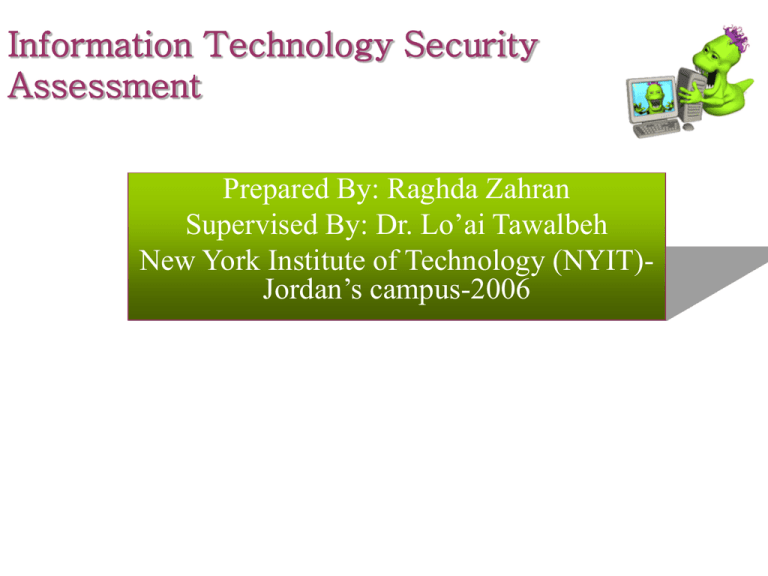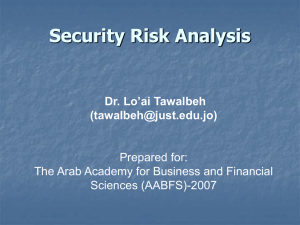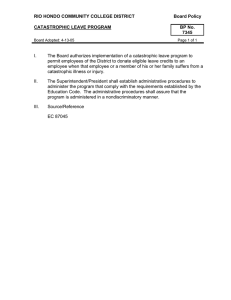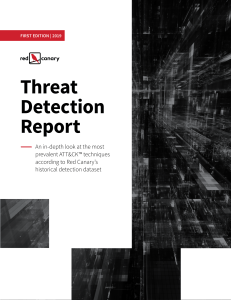Information Technology Security Assessment
advertisement

Information Technology Security Assessment Prepared By: Raghda Zahran Supervised By: Dr. Lo’ai Tawalbeh New York Institute of Technology (NYIT)Jordan’s campus-2006 The Global Threat Information security is not just a paperwork drill…there are dangerous adversaries out there capable of launching serious attacks on our information systems that can result in severe or catastrophic damage to the nation’s critical information infrastructure and ultimately threaten our economic and national security… Critical Infrastructures Examples Energy (electrical, nuclear, gas and oil, dams) Transportation (air, road, rail, port, waterways) Public Health Systems / Emergency Services Information and Telecommunications Defense Industry Banking and Finance Postal and Shipping Agriculture / Food / Water Chemical Computer Security Practices in Nonprofit Organizations • When asked how employees would characterize the state of their own organization's computer security practices, nearly a third of the respondents (32%) acknowledged that their computer security practices needed to be improved. • How respondents described their own organization's computer security? • Threats to Security Connectivity Complexity Which of the following statements best describes your organization's computer security? Does your organization have a data recovery plan to implement in the event of catastrophic data loss? In your opinion, what are the computer security issues that your organization needs to address? The Risks are Real • • • • • • • • • Lost laptops and portable storage devices • Data/Information “left” on public computers • Data/Information intercepted in transmission • Spyware, “malware,” “keystroke logging” • Unprotected computers infected within seconds of being connected to the network • Thousands of attacks on campus networks every day Document Review Risk Identification Vulnerability Scan Requirement Study And Situation Analysis Report & Briefing Data Analysis Risk Management Flow • Investigate • Analyze: Risk Identification Identify the vulnerability and • Analyze : Risk Control investigate how to control vulnerabilities • Design • Implement • Maintain Information Security Program Links in the Security Chain: Management, Operational, and Technical Controls Risk assessment Security planning Security policies and procedures Contingency planning Incident response planning Security awareness and training Physical security Personnel security Certification, accreditation, and security assessments Access control mechanisms Identification & authentication mechanisms (Biometrics, tokens, passwords) Audit mechanisms Encryption mechanisms Firewalls and network security mechanisms Intrusion detection systems Security configuration settings Anti-viral software Smart cards Adversaries attack the weakest link…where is yours? What you need to know • • • • • • IT resources to be managed What’s available on your network Policies, laws & regulations Security Awareness Risk Assessment, Mitigation, & Monitoring Resources to help you The Golden Rules Building an Effective Enterprise Information Security Program Develop an enterprise-wide information security strategy and game plan Get corporate “buy in” for the enterprise information security program—effective programs start at the top Build information security into the infrastructure of the enterprise Establish level of “due diligence” for information security Focus initially on mission/business case impacts—bring in threat information only when specific and credible The Golden Rules Building an Effective Enterprise Information Security Program Create a balanced information security program with management, operational, and technical security controls Employ a solid foundation of security controls first, then build on that foundation guided by an assessment of risk Avoid complicated and expensive risk assessments that rely on flawed assumptions or unverifiable data Harden the target; place multiple barriers between the adversary and enterprise information systems Be a good consumer—beware of vendors trying to sell “single point solutions” for enterprise security problems The Golden Rules Building an Effective Enterprise Information Security Program Don’t be overwhelmed with the enormity or complexity of the information security problem—take one step at a time and build on small successes Don’t tolerate indifference to enterprise information security problems And finally… Manage enterprise risk—don’t try to avoid it! Thanks Q






